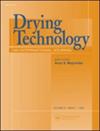热风烘箱作为盐虾酱生产的另一种干燥方法:干燥概况、发酵速率、质量和可接受性
IF 2.7
3区 工程技术
Q3 ENGINEERING, CHEMICAL
引用次数: 0
摘要
摘要本研究探讨了不同温度(35℃、45℃和55℃)的热风烘箱作为传统晒干法生产盐虾酱的替代方法。通过与常规晒干法(CON)的干燥特性、发酵速率、质量和可接受性进行比较,发现在30天的发酵过程中,替代热空气烘箱的酶活性和水解程度较低(p < 0.05)。因此,与对照相比,替代样品的显著特征(颜色、褐变强度、形式、氨、氮含量和抗氧化能力)发育较低,导致感官评分较低(p < 0.05)。有趣的是,热风干燥样品的微生物数量也低于CON (p < 0.05)。基于PCA双图和干燥时间,在45°C的热风烘箱中干燥虾膏似乎是最佳的。然而,需要进行调整,例如延长发酵时间或使用发酵剂培养,以使替代工艺与传统产品相媲美。关键词:虾膏热风烘干工艺发酵速率发酵虾数据可得性声明支持本研究结果的数据可应通讯作者的合理要求获得。作者获得了“人类受试者保护基础课程”证书(NU-NU042),可用于感官评价的初步实验。参与者提供了参与本研究的知情同意书。披露声明作者未报告潜在的竞争利益。本研究由泰国国家研究委员会(NRCT)资助,有才华的青年研究人员研究补助金(2021),批准号:N41A640118)。本文章由计算机程序翻译,如有差异,请以英文原文为准。
The use of hot-air oven as an alternative drying method for salted shrimp paste production: Drying profile, fermentation rate, quality, and acceptability
AbstractThe study explored using a hot-air oven at various temperatures (35, 45, and 55 °C) as a promising alternative to traditional sun-drying for salted shrimp paste production. Comparing drying profiles, fermentation rate, quality, and acceptability with conventional sun-drying (CON), it was found that the alternative hot-air oven led to lower enzymatic activities and degree of hydrolysis during a 30-day fermentation (p < 0.05). Consequently, the alternative samples exhibited lower development of distinctive characteristics (color, browning intensity, formal, ammonia, nitrogen contents, and antioxidant capabilities) resulting in lower sensory scores compared to CON (p < 0.05). Interestingly, microbial populations in hot-air-dried samples were also lower than CON (p < 0.05). Based on PCA biplots and drying duration, drying at 45 °C with a hot-air oven seemed optimal for shrimp paste production. However, adjustments, such as prolonging fermentation or using a starter culture, are needed to make the alternative process comparable to the traditional product.Keywords: Shrimp pastehot-air ovendrying processfermentation ratefermented shrimp Data availability statementThe data that supports the findings of this study are available from the corresponding author upon reasonable request.Ethical statementThe author obtained a certificate of ‘Basic Human Subject Protection Course’ (NU-NU042), which is available for preliminary experiments with sensory evaluations. The participants provided their informed consent to participate in this study.Disclosure statementNo potential competing interest was reported by the authors.Additional informationFundingThis research was funded by the National Research Council of Thailand (NRCT, Research Grants for Talented Young Researchers (2021), grant no. N41A640118).
求助全文
通过发布文献求助,成功后即可免费获取论文全文。
去求助
来源期刊

Drying Technology
工程技术-工程:化工
CiteScore
7.40
自引率
15.20%
发文量
133
审稿时长
2 months
期刊介绍:
Drying Technology explores the science and technology, and the engineering aspects of drying, dewatering, and related topics.
Articles in this multi-disciplinary journal cover the following themes:
-Fundamental and applied aspects of dryers in diverse industrial sectors-
Mathematical modeling of drying and dryers-
Computer modeling of transport processes in multi-phase systems-
Material science aspects of drying-
Transport phenomena in porous media-
Design, scale-up, control and off-design analysis of dryers-
Energy, environmental, safety and techno-economic aspects-
Quality parameters in drying operations-
Pre- and post-drying operations-
Novel drying technologies.
This peer-reviewed journal provides an archival reference for scientists, engineers, and technologists in all industrial sectors and academia concerned with any aspect of thermal or nonthermal dehydration and allied operations.
 求助内容:
求助内容: 应助结果提醒方式:
应助结果提醒方式:


